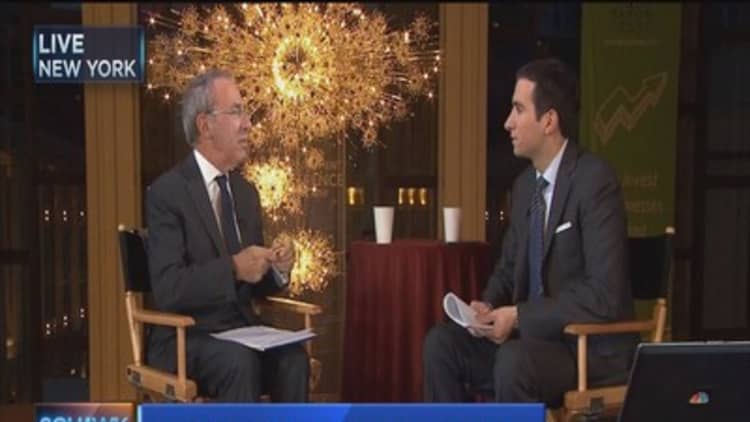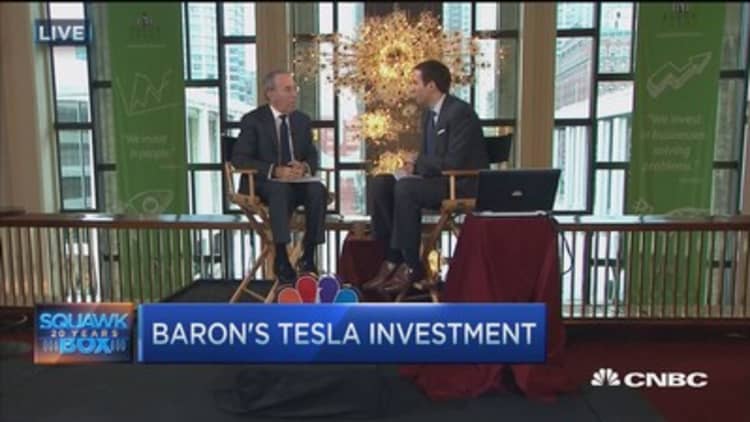Investors are constantly reminded to focus on two factors when choosing a mutual fund: fees and performance. The fees shouldn't be too high, and the performance should be better than the index over the long term. But that two-pronged approach leaves a very important factor out of the analysis — a factor that research suggests can influence the returns generated by a fund: how much money the fund's portfolio manager has invested in their own fund.
This is nothing new — the Securities and Exchange Commission has required funds to disclose ownership by portfolio managers for years as part of a fund prospectus State of Additional Information. The requirement makes perfect logical sense: A fund manager who is invested in their own fund is more likely to be aligned with fund shareholder interests. Or, as they say in the fund industry, "managers who eat their own cooking."
"There's something to be said about viscerally understanding the risk profile of a fund when you have invested in it," said Jon Lukomnik, executive director of the Investor Responsibility Research Center Institute (IRRCi). He also serves on the board of trustees for the Van Eck family of mutual funds, which requires its trustees to invest at least one year out of their first three years of board compensation in the company's funds, even though the SEC does not require this for fund trustees.
Russ Kinnel, director of manager research for Morningstar, wrote in a piece earlier this year that it now has "conclusive data" on the correlation between manager investment in a fund and a fund's performance. Earlier research by Morningstar, which covered the select group of top-tier funds known as the Morningstar 500, found modestly better performance among managers who invested $1 million or above in their own funds. This year, Morningstar found what Kinnel described as "a strong link" across the broader universe of 500 funds.
(The SEC requires managers to disclose only ranges of investment, not precise investment amounts: none, $1–$10,000, $10,001–$50,000, $50,001–$100,000, $100,001–$500,000, $500,001–$1 million, and over $1 million.)
"Funds in which managers invested nothing had the lowest success rate, and those in which a manager had more than $1 million invested had the highest success rate. The rate generally progressed higher with manager investment levels," Morningstar's research found.
Morningstar data on managers and their money
Managers investing no money in their funds had a meager 35 percent success rate.
Those investing between $100,001 and $500,000 had a 43 percent success rate.
Those with more than $1 million had a 47 percent success rate.
In U.S. equities, funds with no investment had a dismal 29 percent success ratio versus 39 percent for the top rung.
For international funds, there was a 32 percent success ratio for managers who invested nothing versus 68 percent for those with more than $1 million invested.
Balanced funds — investing in both stocks and bonds — showed a huge disparity: 32 percent success for managers investing nothing, and 85 percent for those investing $1 million or more.
Note: Morningstar looked at funds going back to 2009. Success is defined as a fund that outperformed its category peer group and a fund that has not been liquidated.
How much is enough?
How much a manager invests is more important than making an investment. Because the SEC only requires disclosure by range of investment, a fund marketer could pitch an investment to an investor or financial advisor by noting the manager is invested, even if the manager is investing $1.
Kinnel said the two bottom rungs of the SEC ranges — $1–$10,000 and $10,001–$50,000 — are inconsequential.
But Kinnel added that the type of fund does matter, and there are reasons why a manager of a noncore fund might be given some "slack," especially on the bond side of fund management. A manager running an ultrashort fund or an emerging markets debt fund would have a "decent reason" not to have $1 million invested, Kinnel said. And an exception has to be made for managers running single-state municipal bond funds, since most managers will not live in the states where those funds are investing in local bonds, eliminating any resident tax benefit. But a manager running a core bond fund should have a significant investment in the fund, Kinnel said. In certain rare cases, Kinnel said a portfolio manager may live in a country where investing in a U.S. mutual fund is not allowed.
Personal investments from Baron Funds' managers
| Name | Ticker | Manager Ownership Level |
|---|---|---|
| Baron Asset | BARAX | Andrew Peck [$1,000,001 and above] |
| Baron Growth | BGRFX | Ronald Baron [$1,000,001 and above] |
| Baron Small Cap | BSCFX | Clifford Greenberg [$1,000,001 and above] |
| Baron Partners | BPTRX | Ronald Baron [$1,000,001 and above] |
| Baron Focused Growth | BFGFX | Ronald Baron [$1,000,001 and above] |
| Baron International Growth | BIGFX | Michael Kass [$1,000,001 and above] |
| Baron Real Estate | BREIX | Jeffrey A. Kolitch [$1,000,001 and above] |
| Baron Emerging Markets | BEXIX | Michael Kass [$1,000,001 and above] |
Source: Source: Morningstar
Pamela DeBolt, associate director at financial services industry consultants Cerulli Associates, and her team used Morningstar research to take a look at fund families that have a relatively sizable investment from portfolio managers and those fund families that aren't cutting it when it comes to "eating their own cooking."
Cerulli said it's not an exact science, due to the way the SEC requires disclosure, but it also found — based on Morningstar star ratings of funds — that the more money portfolio managers invest in their own funds, the greater the percentage of five-star ratings, ranging from 3.6 percent of portfolios for managers that invest between $1,000 and $10,000 to 13.6 percent for managers that invest more than $1 million.
Among the top 50 fund firms by assets under management, 17 percent was the average for funds in which the manager(s) invest more than $1 million.
Forty-nine percent of portfolios had no investment from managers among the 50 largest fund companies, Cerulli found.
There's something to be said about viscerally understanding the risk profile of a fund when you have invested in it.Jon Lukomnikexecutive director of the Investor Responsibility Center Institute (IRRCi)
Cerulli found that some of the firms that have a higher percentage of portfolio managers investing $1 million or more are Dodge & Cox, First Eagle, Artisan Partners, Lord Abbett and Janus.
"It's an indicator of commitment, and these tend to be the portfolio managers who stay with a firm for a long time," DeBolt said. "But $10,000 is not a real commitment."
Cerulli also found that AllianceBernstein, GMO and T. Rowe Price were among the top managers that did not show a high level of manager investment in funds. But those cases point to some of the limitations of this data.
Kinnel said that T. Rowe Price converted many of its funds to a commingled investment structure, and no longer under SEC requirements for mutual funds, don't need to disclose this data. Many large fund companies, including AllianceBernstein, have converted funds to commingled trusts because the structure makes sense for large assets based in the retirement market, and will share it on a case-by-case basis with industry consultants and researchers.
A GMO spokesman said that many of its funds roll up to asset allocation funds of funds, and that is where most of the company's managers invest — and invest significant sums.
The managers of the GMO Benchmark Free Allocation Fund (Ben Inker and Sam Wilderman) each own more than $1 million in the fund.
An AllianceBernstein spokesman said the company has ongoing discussions with Morningstar over what it believes are unfair representations based on the SEC disclosure requirement.
Based on the sheer number of funds where a manager invests $1 million or more, AllianceBernstein is below 40 percent for its portfolios. However, the company contends that its team-based approach to managing funds should be taken into account. Its municipal bond, high-yield bonds and taxable bond funds are managed by the same team in each asset class, and it would not make sense for a manager to invest in each one of those funds, the AllianceBernstein spokesman said. "If a manager runs multiple funds, Morningstar doesn't give them credit. … We disagree with that."
AllianceBernstein contends that based on its team-based approach, almost 80 percent of its funds have a manager that has more than $1 million invested.
Kinnel did not respond to a request for comment on the AllianceBernstein position.



William Birdthistle, a professor at the IIT Chicago-Kent College of Law who worked for the investment management practice at Ropes & Gray, said this ultimately boils down to being a basic concept of good governance.
"If you're running a good shop, this should be a natural. You want to listen closely to the arguments of fund shops who don't do it and try to explain it," Birdthistle advised.
Birdthistle said the better performance found by researchers could be a function of the fact that the firms who make good on this concept are simply better managed than the firms that have to be dragged "kicking and screaming."
Mark Van Clieaf, founding partner with Organizational Capital Partners, which is a consultant on corporate structure, said funds that do "eat their own cooking" shouldn't be congratulated too much. When it comes to aligning corporate management with shareholders interests, mutual funds are still failing shareholders in a major way — by blindly voting against shareholder proposals in annual proxies of the stocks in which their funds invest.
Van Clieaf noted that 75 percent of the S&P 1500 companies have no disclosed metrics and incentives for measuring balance sheet and longer-term capital efficiency performance and alignment with longer-term shareholder value.
"The majority of institutional investors, including mutual funds, have voted for and approved these flawed metrics, performance and incentive design," Van Clieaf said.
He also expressed caution about placing too much faith in this data point alone: "One could suggest that many PMs and senior partners at Bear Sterns, Lehman Brothers and Merrill Lynch also had significant investment in their own firms and funds. That did not end well for most investors," Van Clieaf said.








